Page 1420 of 1575
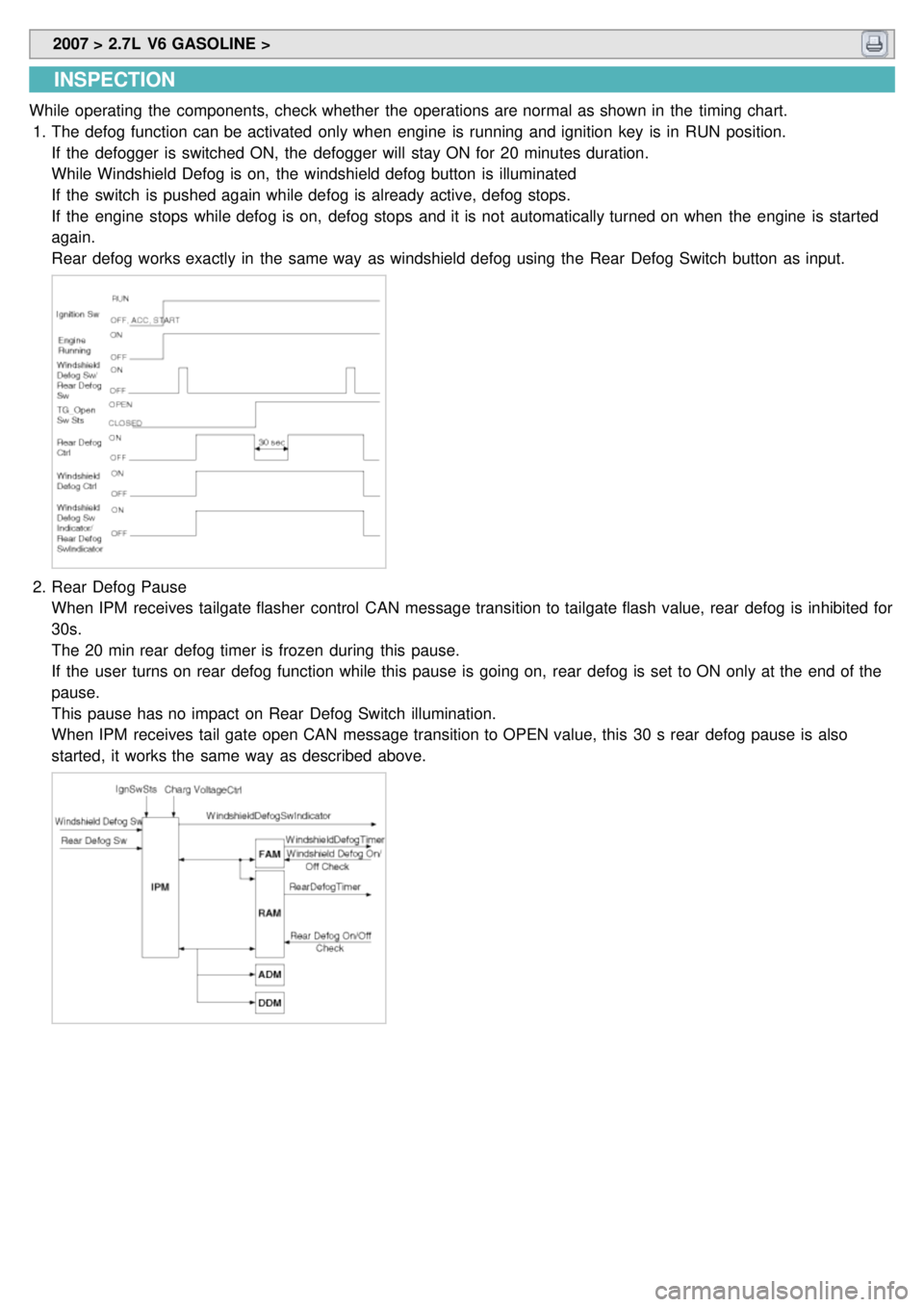
2007 > 2.7L V6 GASOLINE >
INSPECTION
While operating the components, check whether the operations are normal as shown in the timing chart.
1. The defog function can be activated only when engine is running and ignition key is in RUN position.
If the defogger is switched ON, the defogger will stay ON for 20 minutes duration.
While Windshield Defog is on, the windshield defog button is illuminated
If the switch is pushed again while defog is already active, defog stops.
If the engine stops while defog is on, defog stops and it is not automatically turned on when the engine is started
again.
Rear defog works exactly in the same way as windshield defog using the Rear Defog Switch button as input.
2.Rear Defog Pause
When IPM receives tailgate flasher control CAN message transition to tailgate flash value, rear defog is inhibited for
30s.
The 20 min rear defog timer is frozen during this pause.
If the user turns on rear defog function while this pause is going on, rear defog is set to ON only at the end of the
pause.
This pause has no impact on Rear Defog Switch illumination.
When IPM receives tail gate open CAN message transition to OPEN value, this 30 s rear defog pause is also
started, it works the same way as described above.
Page 1499 of 1575
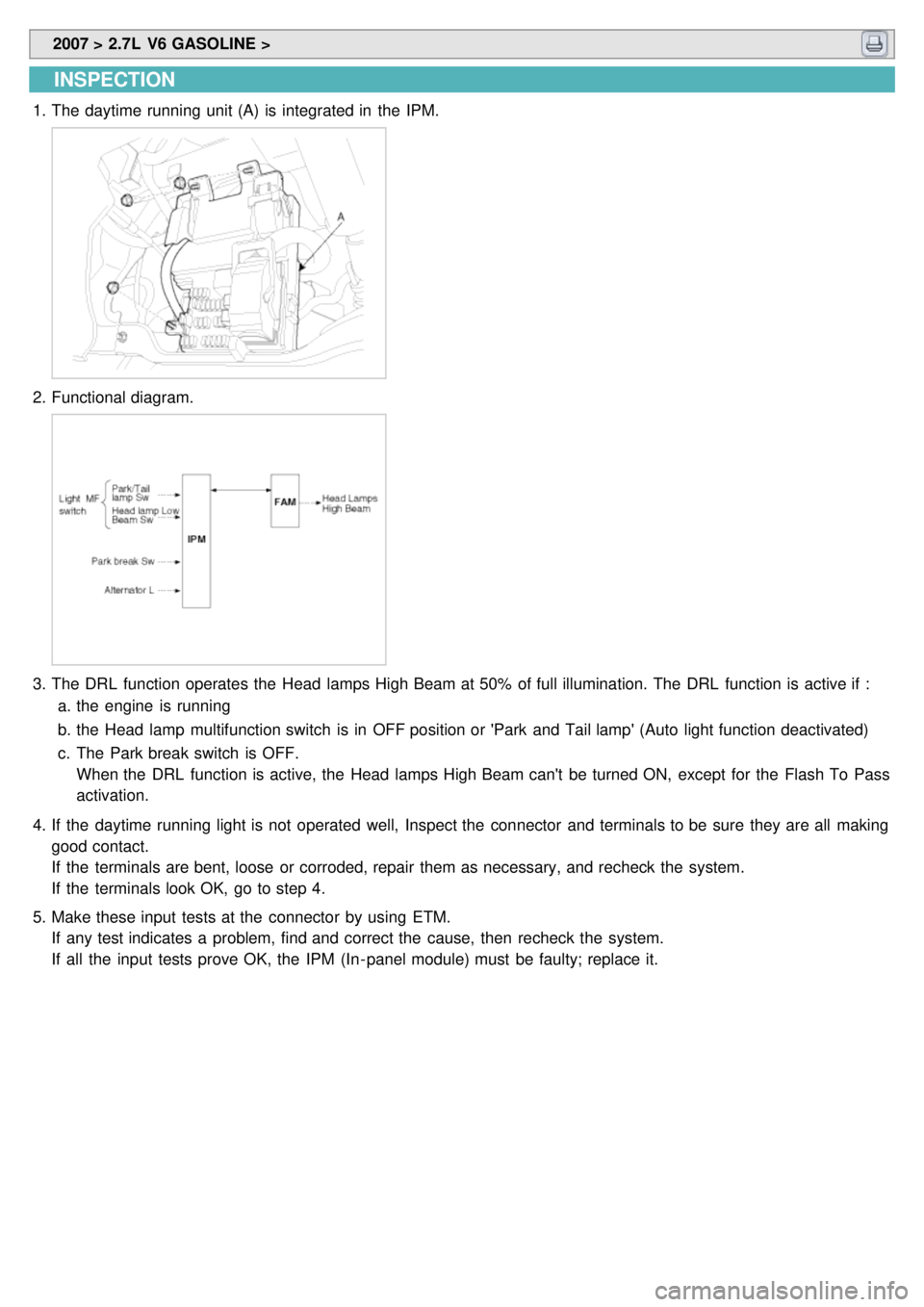
2007 > 2.7L V6 GASOLINE >
INSPECTION
1.The daytime running unit (A) is integrated in the IPM.
2.Functional diagram.
3.The DRL function operates the Head lamps High Beam at 50% of full illumination. The DRL function is active if :
a. the engine is running
b. the Head lamp multifunction switch is in OFF position or 'Park and Tail lamp' (Auto light function deactivated)
c. The Park break switch is OFF.
When the DRL function is active, the Head lamps High Beam can't be turned ON, except for the Flash To Pass
activation.
4. If the daytime running light is not operated well, Inspect the connector and terminals to be sure they are all making
good contact.
If the terminals are bent, loose or corroded, repair them as necessary, and recheck the system.
If the terminals look OK, go to step 4.
5. Make these input tests at the connector by using ETM.
If any test indicates a problem, find and correct the cause, then recheck the system.
If all the input tests prove OK, the IPM (In - panel module) must be faulty; replace it.
Page 1503 of 1575
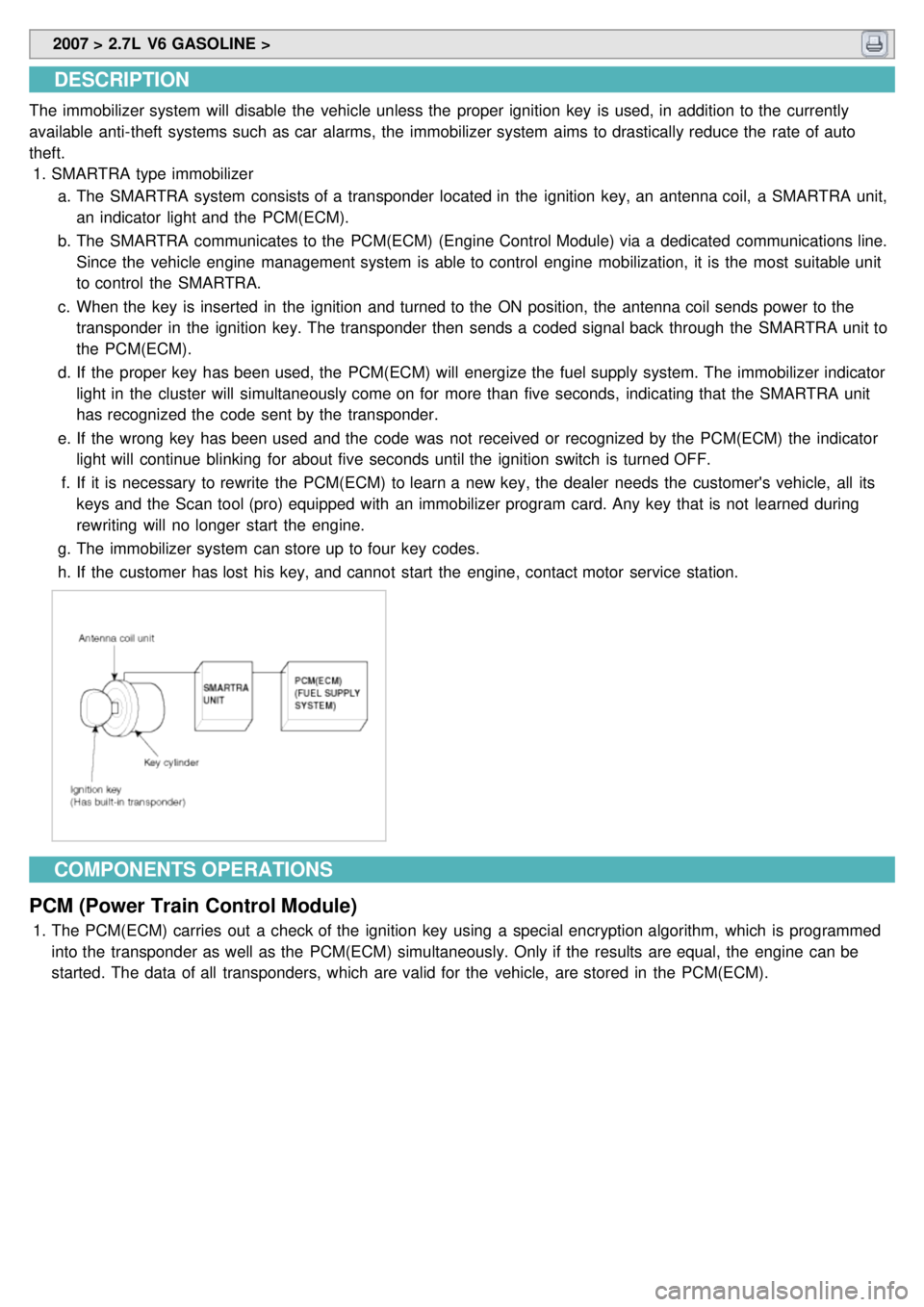
2007 > 2.7L V6 GASOLINE >
DESCRIPTION
The immobilizer system will disable the vehicle unless the proper ignition key is used, in addition to the currently
available anti- theft systems such as car alarms, the immobilizer system aims to drastically reduce the rate of auto
theft.
1. SMARTRA type immobilizer
a. The SMARTRA system consists of a transponder located in the ignition key, an antenna coil, a SMARTRA unit,
an indicator light and the PCM(ECM).
b. The SMARTRA communicates to the PCM(ECM) (Engine Control Module) via a dedicated communications line.
Since the vehicle engine management system is able to control engine mobilization, it is the most suitable unit
to control the SMARTRA.
c. When the key is inserted in the ignition and turned to the ON position, the antenna coil sends power to the
transponder in the ignition key. The transponder then sends a coded signal back through the SMARTRA unit to
the PCM(ECM).
d. If the proper key has been used, the PCM(ECM) will energize the fuel supply system. The immobilizer indicator
light in the cluster will simultaneously come on for more than five seconds, indicating that the SMARTRA unit
has recognized the code sent by the transponder.
e. If the wrong key has been used and the code was not received or recognized by the PCM(ECM) the indicator
light will continue blinking for about five seconds until the ignition switch is turned OFF.
f. If it is necessary to rewrite the PCM(ECM) to learn a new key, the dealer needs the customer's vehicle, all its
keys and the Scan tool (pro) equipped with an immobilizer program card. Any key that is not learned during
rewriting will no longer start the engine.
g. The immobilizer system can store up to four key codes.
h. If the customer has lost his key, and cannot start the engine, contact motor service station.
COMPONENTS OPERATIONS
PCM (Power Train Control Module)
1. The PCM(ECM) carries out a check of the ignition key using a special encryption algorithm, which is programmed
into the transponder as well as the PCM(ECM) simultaneously. Only if the results are equal, the engine can be
started. The data of all transponders, which are valid for the vehicle, are stored in the PCM(ECM).
Page 1515 of 1575
LIMP HOME FUNCTION
1.LIMP HOME BY TESTER
If the PCM(ECM) detects the fault of the SMARTRA or transponder, the PCM(ECM) will allow limp home function of
the immobilizer. Limp home is only possible if the user password (4 digits) has been given to the PCM(ECM)
before. This password can be selected by the vehicle owner and is programmed at the service station.
The user password can be sent to the PCM(ECM) via the special tester menu.
Only if the PCM(ECM) is in status "learnt" and the user password status is "learnt" and the user password is
correct, the PCM(ECM) will be unlocked for a period of time (30 sec.). The engine can only be started during this
time. After the time has elapsed, engine start is not possible.
If the wrong user password is sent, the PCM(ECM) will reject the request of limp home for one hour. Disconnecting
the battery or any other action cannot reduce this time. After connecting the battery to the PCM(ECM), the timer
starts again for one hour.
Page 1516 of 1575
2.LIMP HOME BY IGNITION KEY
The limp home can be activated also by the ignition key. The user password can be input to the PCM(ECM) by a
special sequence of ignition on/off.
Only if the PCM(ECM) is in status "learnt" and the user password status is "learnt" and the user password is
correct, the PCM(ECM) will be unlocked for a period of time (30 sec.). The engine can be started during this time.
After the time has elapsed, engine start is not possible. After a new password has been input, the timer (30 sec.)
will start again.
After ignition off, the PCM(ECM) is locked if the timer has elapsed 8 seconds. For the next start, the input of the
user password is requested again.
Page 1518 of 1575
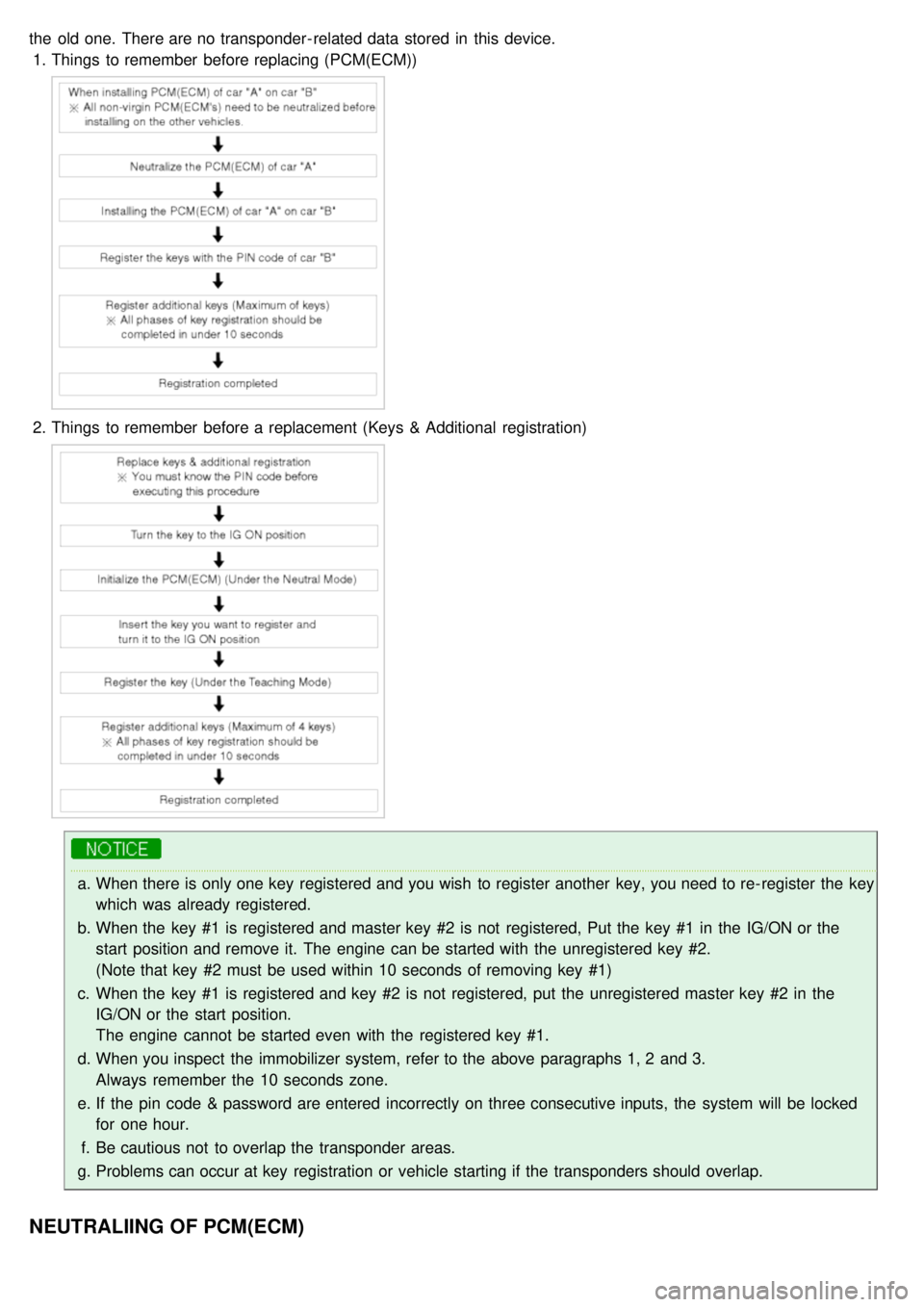
the old one. There are no transponder- related data stored in this device.1. Things to remember before replacing (PCM(ECM))
2.Things to remember before a replacement (Keys & Additional registration)
a.When there is only one key registered and you wish to register another key, you need to re- register the key
which was already registered.
b. When the key #1 is registered and master key #2 is not registered, Put the key #1 in the IG/ON or the
start position and remove it. The engine can be started with the unregistered key #2.
(Note that key #2 must be used within 10 seconds of removing key #1)
c. When the key #1 is registered and key #2 is not registered, put the unregistered master key #2 in the
IG/ON or the start position.
The engine cannot be started even with the registered key #1.
d. When you inspect the immobilizer system, refer to the above paragraphs 1, 2 and 3.
Always remember the 10 seconds zone.
e. If the pin code & password are entered incorrectly on three consecutive inputs, the system will be locked
for one hour.
f. Be cautious not to overlap the transponder areas.
g. Problems can occur at key registration or vehicle starting if the transponders should overlap.
NEUTRALIING OF PCM(ECM)
Page 1526 of 1575
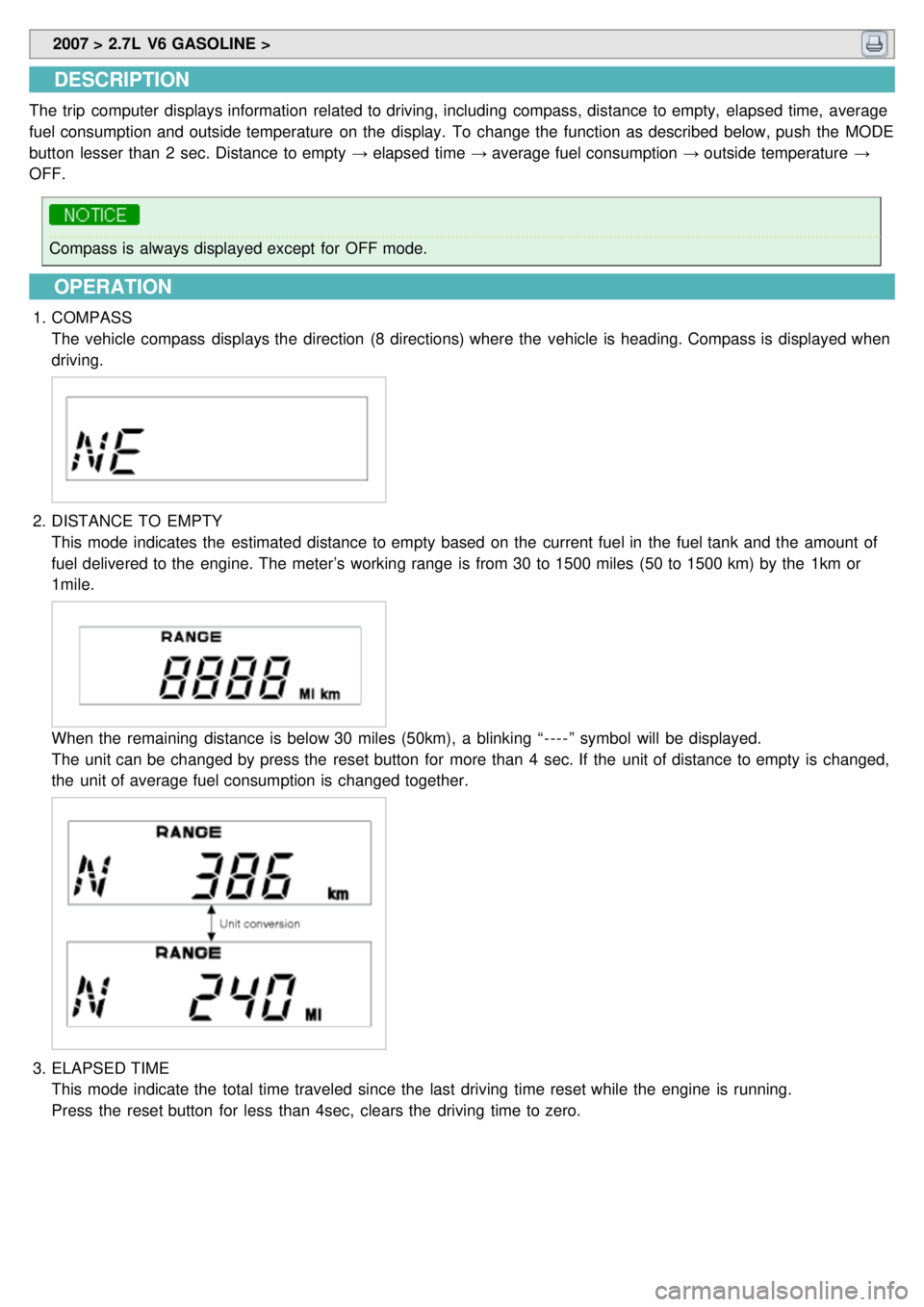
2007 > 2.7L V6 GASOLINE >
DESCRIPTION
The trip computer displays information related to driving, including compass, distance to empty, elapsed time, average
fuel consumption and outside temperature on the display. To change the function as described below, push the MODE
button lesser than 2 sec. Distance to empty → elapsed time → average fuel consumption → outside temperature →
OFF.
Compass is always displayed except for OFF mode.
OPERATION
1. COMPASS
The vehicle compass displays the direction (8 directions) where the vehicle is heading. Compass is displayed when
driving.
2.DISTANCE TO EMPTY
This mode indicates the estimated distance to empty based on the current fuel in the fuel tank and the amount of
fuel delivered to the engine. The meter’s working range is from 30 to 1500 miles (50 to 1500 km) by the 1km or
1mile.
When the remaining distance is below 30 miles (50km), a blinking “ - - - - ” symbol will be displayed.
The unit can be changed by press the reset button for more than 4 sec. If the unit of distance to empty is changed,
the unit of average fuel consumption is changed together.
3.ELAPSED TIME
This mode indicate the total time traveled since the last driving time reset while the engine is running.
Press the reset button for less than 4sec, clears the driving time to zero.
Page 1533 of 1575
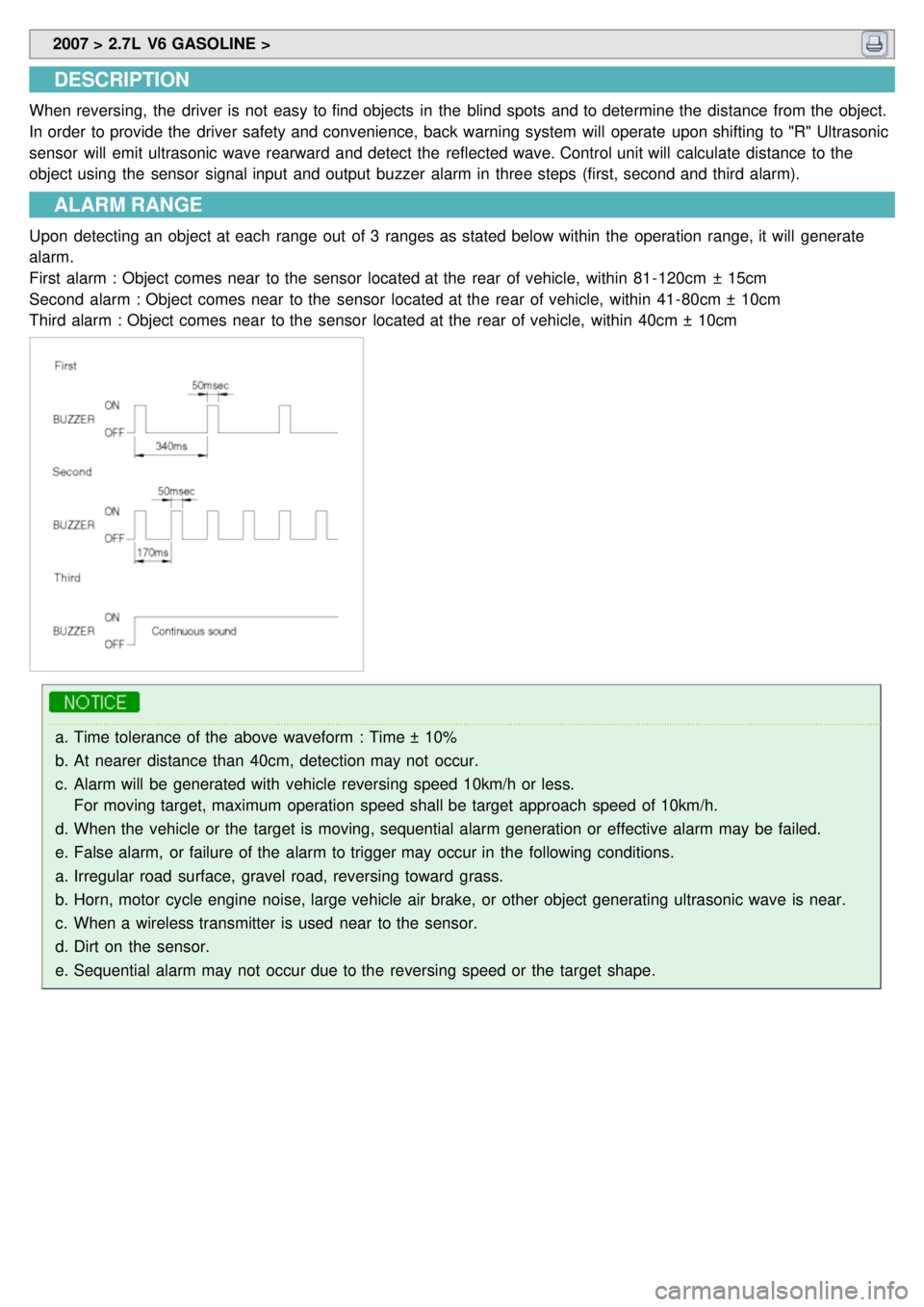
2007 > 2.7L V6 GASOLINE >
DESCRIPTION
When reversing, the driver is not easy to find objects in the blind spots and to determine the distance from the object.
In order to provide the driver safety and convenience, back warning system will operate upon shifting to "R" Ultrasonic
sensor will emit ultrasonic wave rearward and detect the reflected wave. Control unit will calculate distance to the
object using the sensor signal input and output buzzer alarm in three steps (first, second and third alarm).
ALARM RANGE
Upon detecting an object at each range out of 3 ranges as stated below within the operation range, it will generate
alarm.
First alarm : Object comes near to the sensor located at the rear of vehicle, within 81- 120cm ± 15cm
Second alarm : Object comes near to the sensor located at the rear of vehicle, within 41- 80cm ± 10cm
Third alarm : Object comes near to the sensor located at the rear of vehicle, within 40cm ± 10cm
a.Time tolerance of the above waveform : Time ± 10%
b. At nearer distance than 40cm, detection may not occur.
c. Alarm will be generated with vehicle reversing speed 10km/h or less.
For moving target, maximum operation speed shall be target approach speed of 10km/h.
d. When the vehicle or the target is moving, sequential alarm generation or effective alarm may be failed.
e. False alarm, or failure of the alarm to trigger may occur in the following conditions.
a. Irregular road surface, gravel road, reversing toward grass.
b. Horn, motor cycle engine noise, large vehicle air brake, or other object generating ultrasonic wave is near.
c. When a wireless transmitter is used near to the sensor.
d. Dirt on the sensor.
e. Sequential alarm may not occur due to the reversing speed or the target shape.